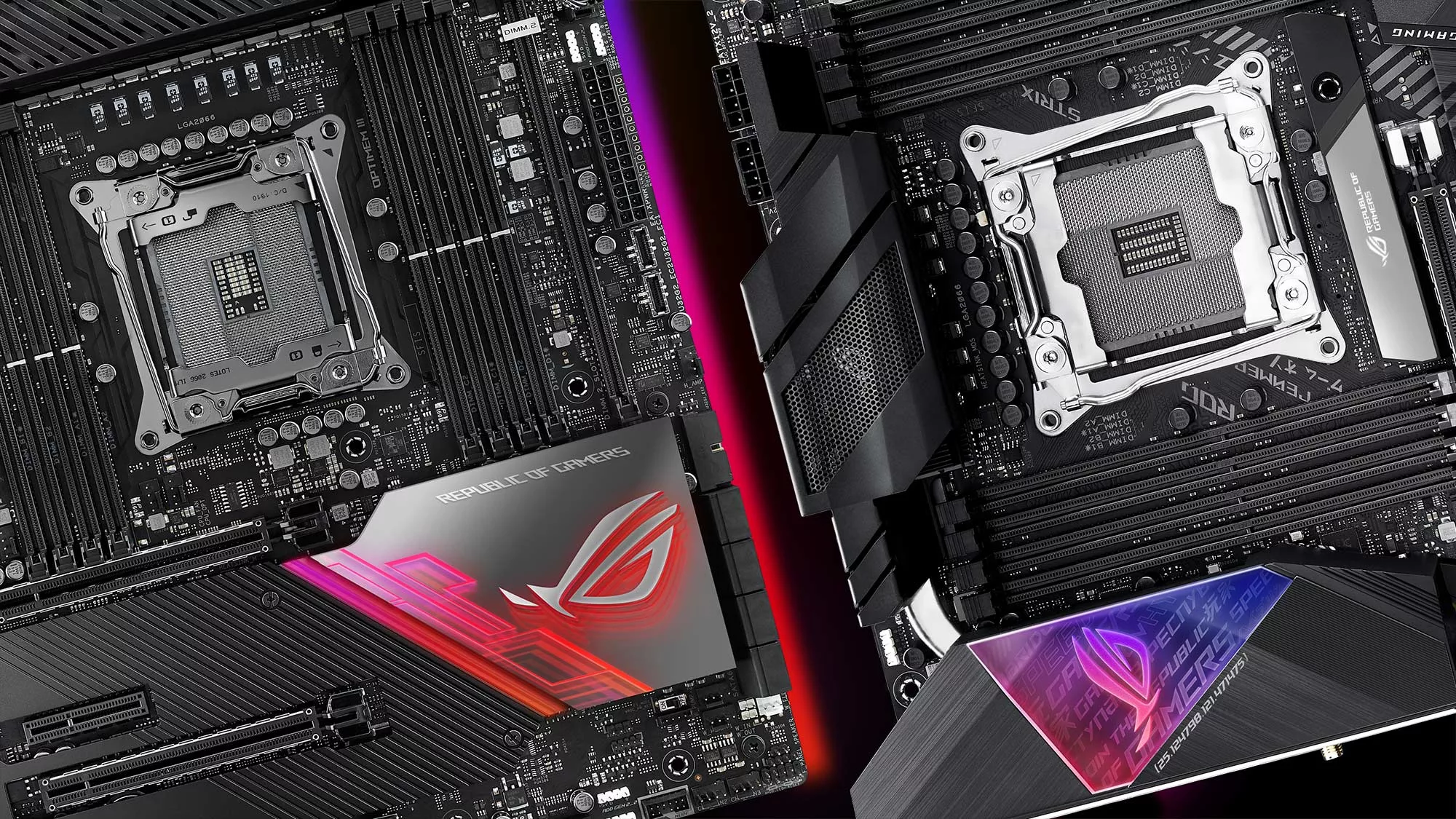Ryzen™ to the challenge: choosing the right ROG X570 motherboard
AMD’s 1st and 2nd Gen Ryzen™ desktop processors are made for hardcore gamers. They pack lots of cores underneath their heat spreaders, and every model offers Simultaneous Multi-Threading (SMT) for extra parallel computing power, which is just the ticket for heavy multitasking, like gaming while streaming. Now, AMD is returning with a new generation of Ryzen CPUs that combine its Zen 2 architecture and next-gen PCI Express 4.0 (PCIe) connectivity for more bandwidth and performance than previous iterations. The family remains focused on heavy lifting with up to 12 cores and 24 threads in a single chip, a class of processor that really needs a quality motherboard.
It takes all kinds to build a Republic, so our family of X570 motherboards runs the gamut to make sure there’s a board for every build, whether you’re putting together a small-form-factor PC or the biggest, baddest rig you can muster. The ROG Crosshair VIII boards are fit for the most demanding overclockers and gamers looking to extract every ounce of performance from their systems, while our ROG Strix series couples good looks with strong core performance. Read on for the rundown of every ROG motherboard based on AMD’s X570 chipset.
Extreme bandwidth for extreme storage and peripherals
New Ryzen processors are designed to pair with the X570 chipset, the first desktop chipset to put PCI Express 4.0 connectivity at your disposal. The brand-new spec doubles peak throughput to 2GB/s per lane, paving the way for a new generation of graphics cards, solid-state drives, and peripherals. A four-lane NVMe SSD based on PCIe 3.0 can reach a maximum raw speed of close to 4GB/s. That’s pretty fast but already capping the performance of modern drives. With PCIe 4.0 on the X570 platform, the same number of lanes gives devices peak raw bandwidth of 7.9GB/s, a figure previously only attainable with a multi-drive RAID 0 array and a direct connection to the CPU. Future graphics cards sitting in x16 slots will have nearly 32GB/s of bandwidth available, laying the foundation for games with higher-resolution textures, and letting machine-learning algorithms access more data faster than ever before.
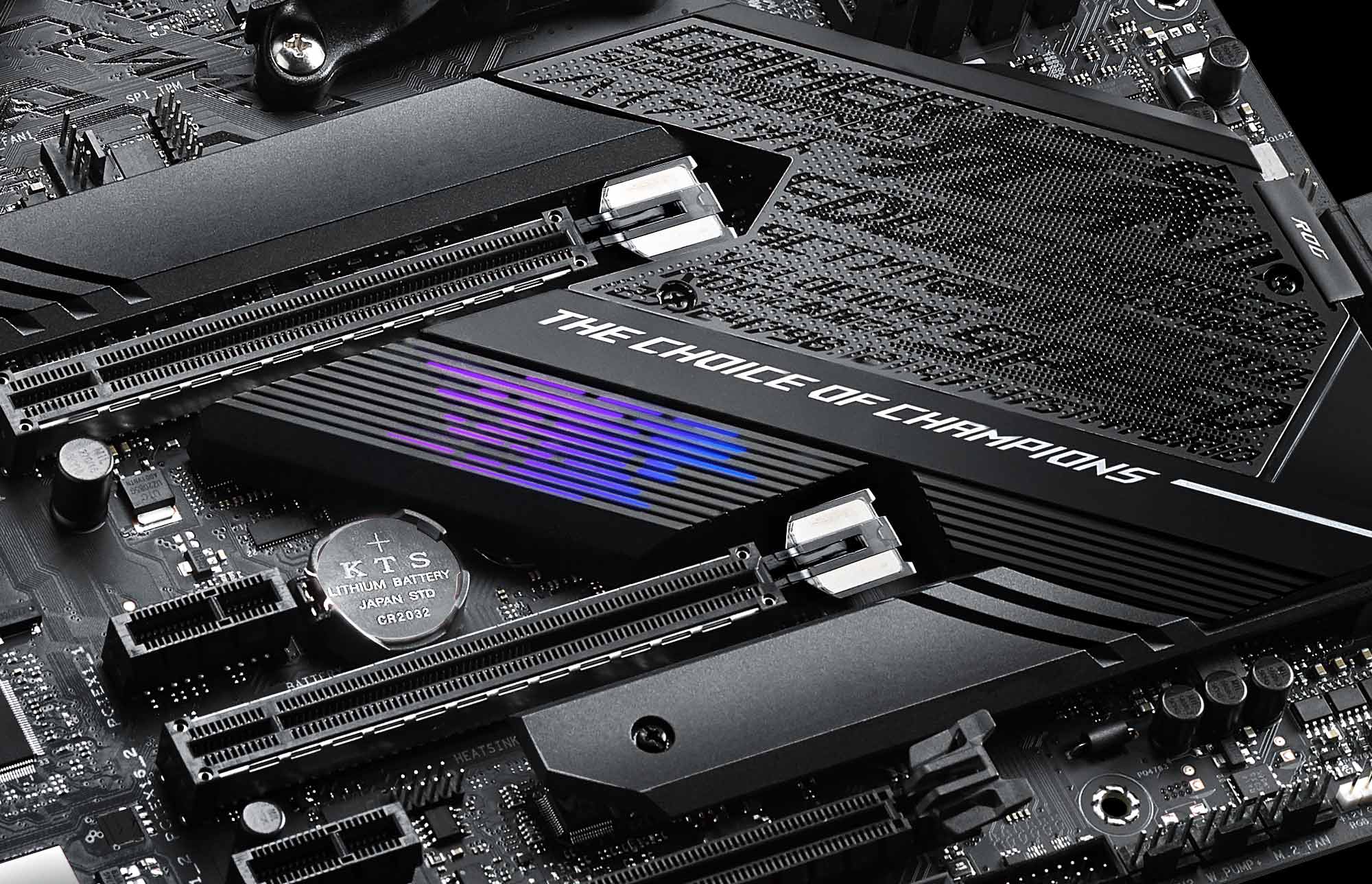
No matter which ROG X570 motherboard you choose, we want to ensure you can take advantage of the power of PCI Express 4.0. Every single PCIe x16 and M.2 slot on our lineup is wired with PCIe 4.0, so no matter the model, you can use a next-gen graphics card or NVMe drive without fear it'll be bandwidth-constrained.
High wattage, low temperatures
Hosting a high-end CPU requires a voltage regulator module (VRM) that can not only supply the chip with a sizable amount of stable power, but also adapt quickly to drastic shifts in demand. This is why we’ve designed our new X570 motherboards to use digital ICs feeding control signals directly to teamed power stages for improved transient response. The ROG Crosshair ATX models in particular offer 16 IR3555 PowIRstages, split between the CPU and the SOC, each rated for 60 amps. Great power requires great cooling, so ROG ATX boards employ large VRM heatsinks that strike the right balance between surface area and mass.
All of our X570 motherboards include sizable chipset heatsinks coupled with efficient fans that help the underlying silicon stay cool under pressure. With double the bandwidth via PCIe 4.0, the X570 presents a greater thermal challenge than its X470 predecessor. Higher-end models have extra-large chipset heatsinks that improve cooling by also covering multiple M.2 slots, and all offer integrated cooling for at least one M.2 SSD. Small-form-factor boards from both the ROG and Strix families integrate an additional fan dedicated to cooling the VRMs under extreme power draw like heavy overclocking. The extra fan helps compensate for their smaller heatsinks and the limited airflow inside compact cases.
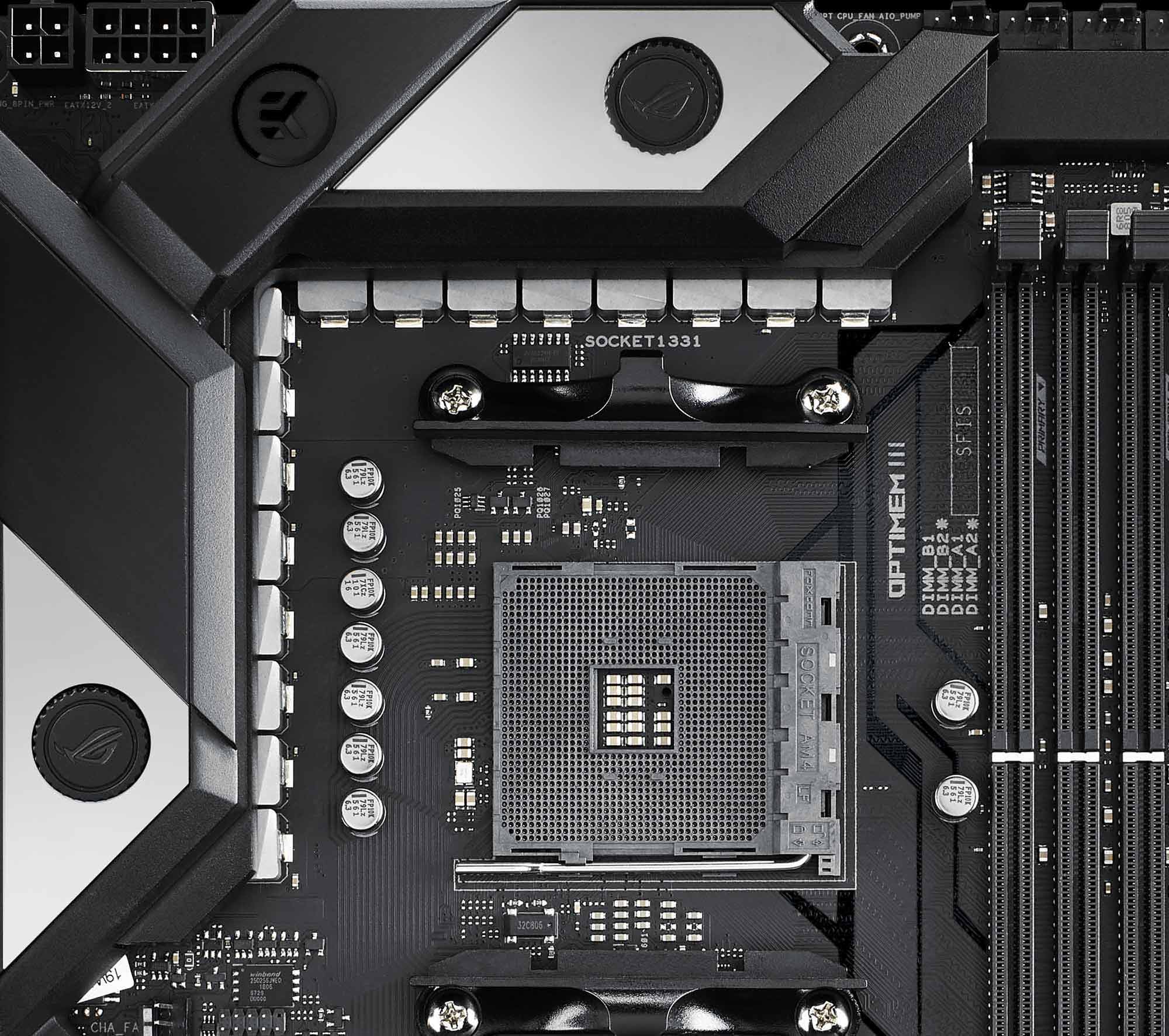
Having heatsinks on the motherboard is vital, but they’re only one aspect of maintaining a chilly PC. Efficient airflow through the case and around components is key to keeping temperatures low and clock speeds high. Our X570 boards are loaded with hybrid fan headers that know if they’re hooked up to 3-pin DC or 4-pin PWM fans, and adjust accordingly. Most also include a dedicated AIO pump header that makes it easier to set up common all-in-one liquid coolers. You choose the temperature sensor that dictates the speed of each fan and whether it responds based on a preset profile or a custom curve you tweak yourself. All the grades are available between loud and fast for maximum performance, and quiet and smooth for unobtrusive acoustics. With our FanXpert 4 software, you can even configure individual system fans to respond to the temperature of not only the CPU, but also the GPU on compatible ASUS graphics cards. This capability enables optimal cooling for any workload, from processor-heavy tasks to graphics-intensive gaming.
For more ambitious liquid cooling, mid-range and high-end boards include a dedicated pump header primed to power a custom loop. The Crosshair VIII series also has headers for tracking coolant temperatures and flow rate for those who obsessively monitor their machines. The Crosshair VIII Formula goes a couple steps further still, employing a CrossChill EK III hybrid cooler that covers the VRM with a combined water block and heatsink that works with both air cooling and standard fittings for liquid plumbing.
Networking is key to a happy team
Desktop machines are often tethered to the outside world with a cable, but as wireless speeds climb higher and latency drops, more gamers and professionals are turning to fast Wi-Fi for their networking needs. To keep them on the cutting edge, we fitted most of our ROG boards with brand-new Intel Wi-Fi 6 AX200 adapters. Recently released, they support the latest 802.11ax protocol and can broadcast blazing-fast signals up to a theoretical peak of 2400Mbps. At that kind of speed, cables are an option, not a necessity.
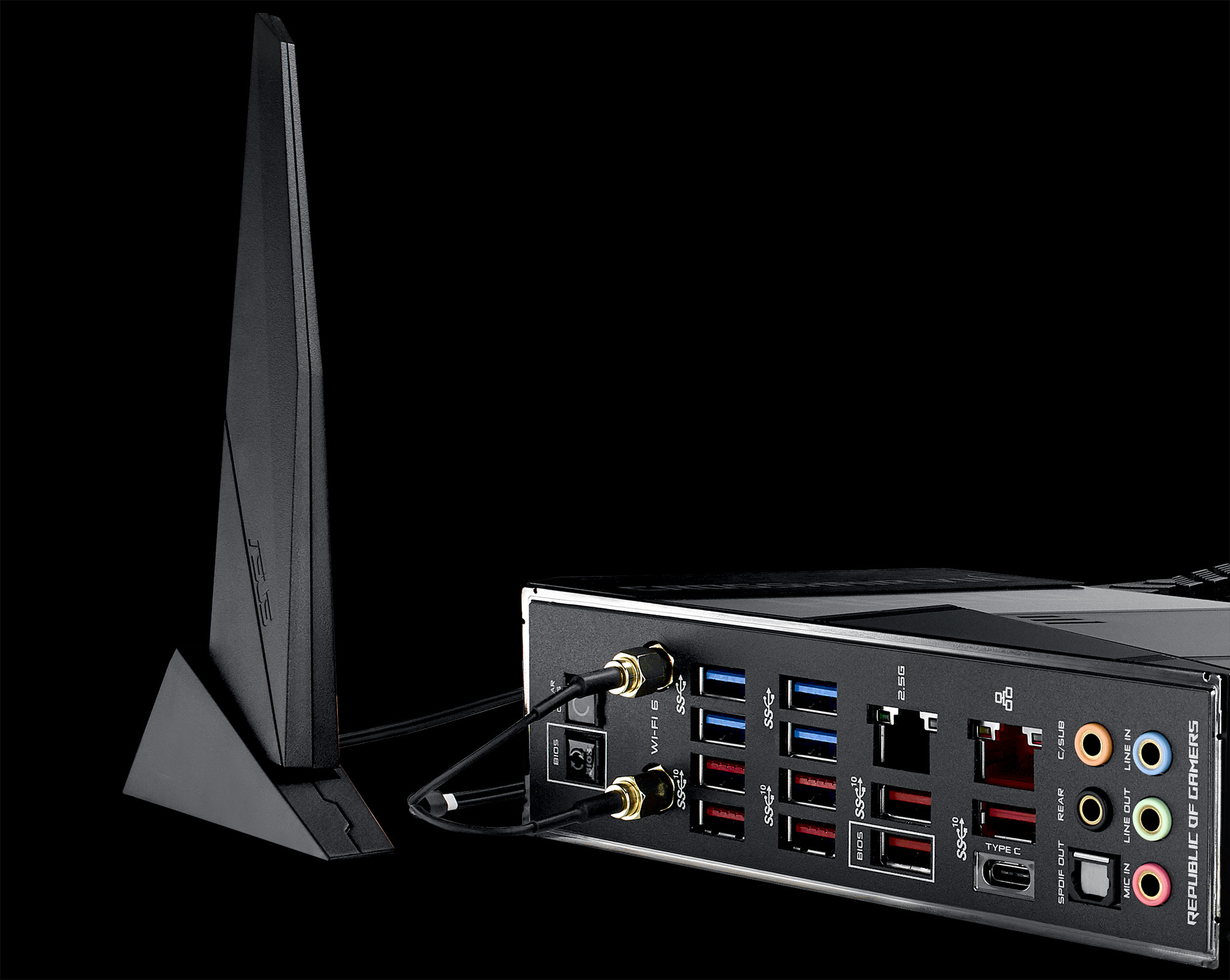
Raw throughput is only part of the story, though. The latest Wi-Fi technology fares much better than 802.11ac and its predecessors in crowded environments like apartment buildings and dorm rooms, where lots of devices and networks are competing. Latency is likewise improved—when using an 802.11ax access point or router like the ROG Rapture GT-AX11000 or the RT-AX88U, ping times can be lower than before thanks to the magic of OFDMA, letting you dominate online matches even when using a wireless connection. Additionally, the AX200 adapter supports Bluetooth 5.0 for easy pairing and quick data transfer with devices like headsets and phones.
You can’t beat wires when you need ultra-low latency and steady speeds. Intel’s networking chips are some of the best and business, so we’ve added its I211AT Gigabit Ethernet controller to almost the entirety of our X570 lineup. Higher-end Crosshair and Strix boards have additional Aquantia 5G or Realtek 2.5G Ethernet controllers that enable even higher speeds to easily handle multi-terabyte file transfers on fast networks. Along with the rest of the ROG models, they also feature enhanced GameFirst V network packet prioritization capabilities.
OptiMem III
ROG X570 boards are fitted with our latest-gen OptiMem III technology. This exclusive tech offers additional margin for memory tuning compared to the previous generation—even when tested using an identical 2nd Gen Ryzen processor on the same board with and without this technology. Look forward to announcements on 3rd Gen Ryzen RAM performance as the launch draws nearer.
Turn on the bright lights
Motherboards aren’t just functional; they’re works of art in their own right. Our X570 series couples advanced engineering with meticulous design to create boards that form the centerpiece of any build. Every member of the family has an integrated I/O shield for streamlined looks and easier installation, as well as integrated Aura Sync RGB lighting with carefully placed diffusers for exquisite illumination. The Crosshair and Strix series have multi-zone lighting and graphical styling in subdued monochrome tones to avoid clashing with colored lighting. Should you find the glow distracting (say, when playing a horror game or watching a movie), it’s easy to slip into stealth mode to enforce a total blackout that includes secondary diagnostic LEDs.
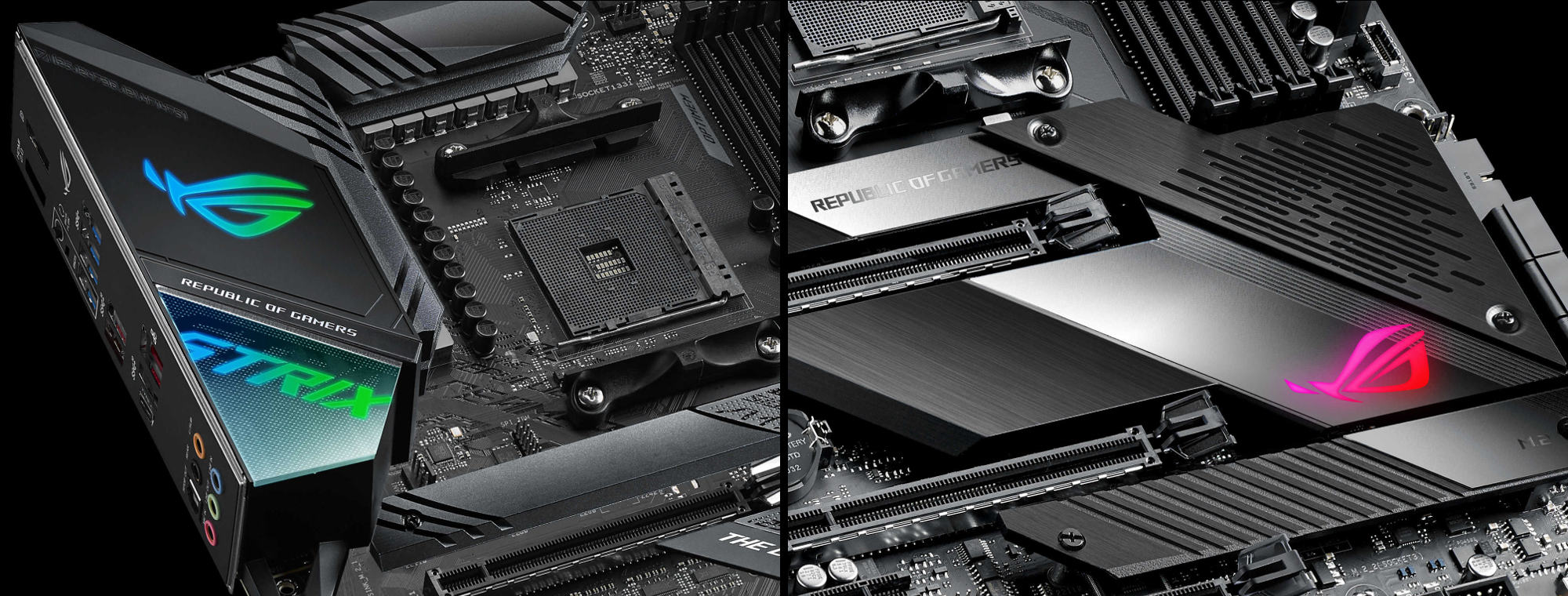
Having lots of RGBs across your machine and peripherals can look like a real mess if the lighting is difficult to tweak and synchronize for a cohesive look. Aura Sync offers the most complete ecosystem of compatible components along with intuitive software that puts the controls at your fingertips. It’s available across all of our RGB-equipped X570 boards, letting you configure multiple components and peripherals from ASUS and our partners with just a few clicks. Lighting up your battlestation and its accessories has never been easier. Developers can also use our freely available Aura SDK to roll their own effects and link system lighting to games or applications. Call of Duty: Black Ops 4, Anthem, and other titles already heighten immersion by using Aura Sync to reflect some of what’s happening in-game.
Customized chassis lighting is key, so you’ll find plenty of headers for RGB LED strips on almost every one of our X570 boards. Headers for addressable strips that allow control over individual LEDs enable more advanced effects and extensive personalization. ROG boards include upgraded addressable headers ready for next-generation lighting devices. These Gen 2 headers can detect how many addressable LEDs are on an attached device, simplifying the setup process and allowing software to automatically configure lighting effects. They’re backed by a new, low-latency controller capable of lighting every LED on long strips in a perfectly synchronized dance. The new headers are backward-compatible, so existing addressable RGB strips work fine, too.
Additionally, most high-end models in our X570 lineup come with a Node connector that allows bidirectional communication between the motherboard and compatible devices. This creates new possibilities like the ability to monitor system accessories or peripherals, or have external devices control board features.
A pleasant burst of sound waves
When talking about immersion, we tend to think of visuals first, but sound also plays an important role. The audio chips and associated circuitry on our X570 motherboards have been scrupulously designed for crystal-clear sound processing and output. Your teammates will appreciate the clarity of your communication, and woe to enemies who try to sneak up on you.
The ROG Crosshair and Strix series carry premium SupremeFX audio solutions with integrated amplifiers and op-amps. Auto impedance detection lets you use even high-impedance audiophile headphones and get crystal-clear, distortion-free output. The onboard codecs are capable of a 120 dB output signal-to-noise ratio and 113 dB mic input SNR for crisp squad communication. The Crosshairs put an ESS Sabre DAC to good use pumping top-notch audio to the front-panel output, which is perfect for plugging in high-quality headphones. The Strix employ a similar SupremeFX S1220A solution that drops the dedicated front-panel DAC but otherwise keeps the same high-end circuitry. No matter the motherboard, the audio circuit design uses Japanese capacitors, interference shielding, and discrete traces for the left and right channels.

Our SonicStudio III software can inject virtual surround sound and other effects into any audio device, whether it’s analog headphones, a USB DAC, or a VR headset; it even works with Bluetooth gear. The virtual mixer is particularly handy for streamers, as it allows routing multiple audio sources at once (like game sound, music, and your own voice) into a single virtual device for broadcasting or recording. The ROG boards offer DTS Sound Unbound technology for object-based audio, letting you enjoy next-gen surround sound virtualization that also allows sound to be mapped above and below you in compatible games.
Detail is key
Attention to detail separates merely good motherboards from the absolute best. The small touches we add ensure a smooth assembly and setup experience. Reliability is assured thanks to a host of physical and electrical protection measures. Each and every one of our X570 boards has overvoltage and ESD protection, and higher-end models boast Ethernet ports with LANGuard power spike protection and reinforced electronics for cleaner signaling. Modern graphics cards hang heavy coolers off the PCIe x16 slot, so we reinforce it with SafeSlot metal armor and nickel clips that improve durability and offer peace of mind. The Crosshair and Strix models both feature ProCool power connectors featuring beefier pins and metal casings.
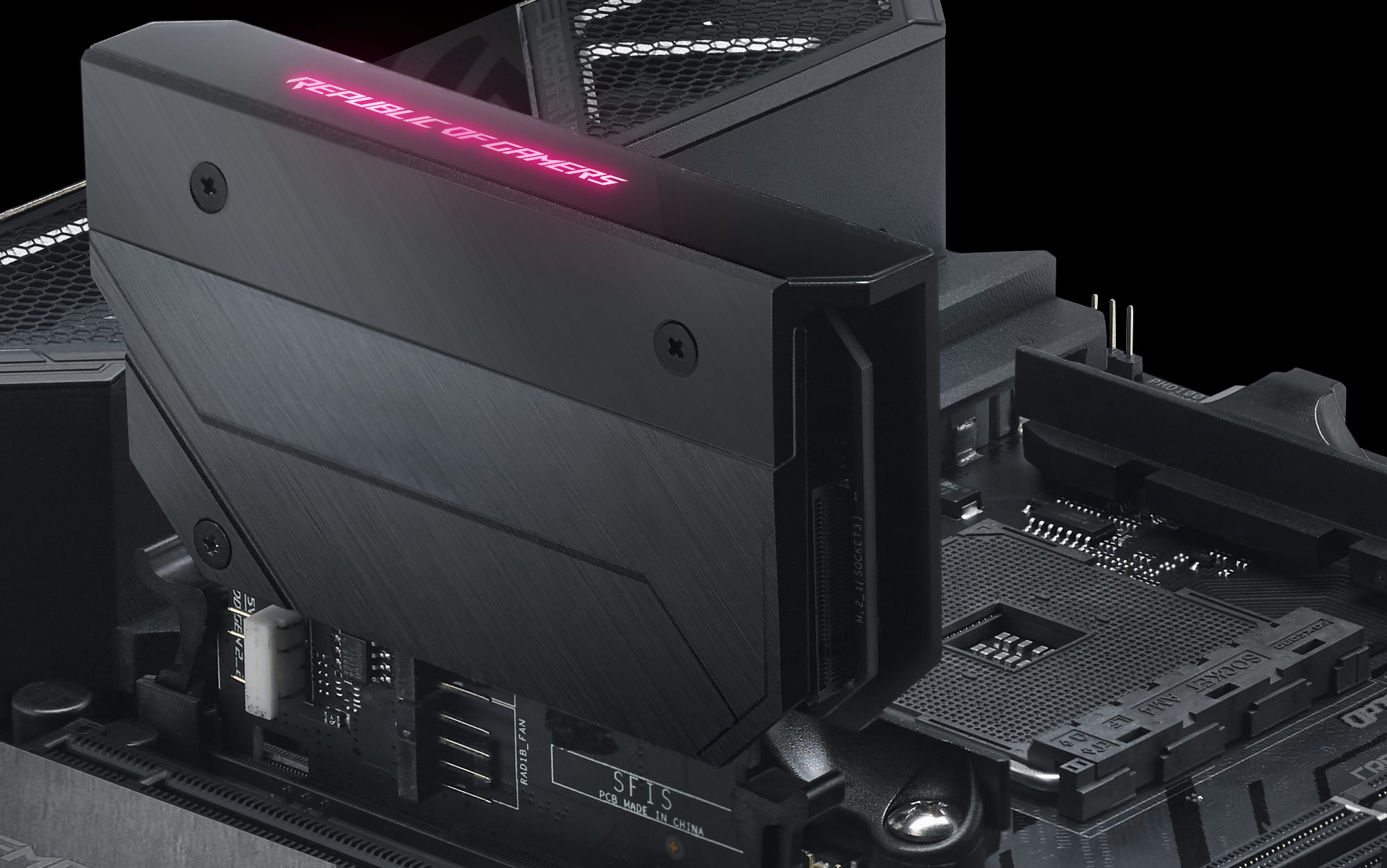
Having a ton of features at hand isn’t very useful if they’re hard to use. Thanks to Easy and Advanced setup modes, our critically acclaimed UEFI lets both beginners and experts get a system up and running with minimal fuss. Any changes made to the UEFI are summarized in a handy panel before saving and rebooting, so it’s easy to check what changed (and what didn’t). Tweakers, overclockers, and enthusiasts can dig into the expert menus to tune every aspect of the motherboard to do their bidding.
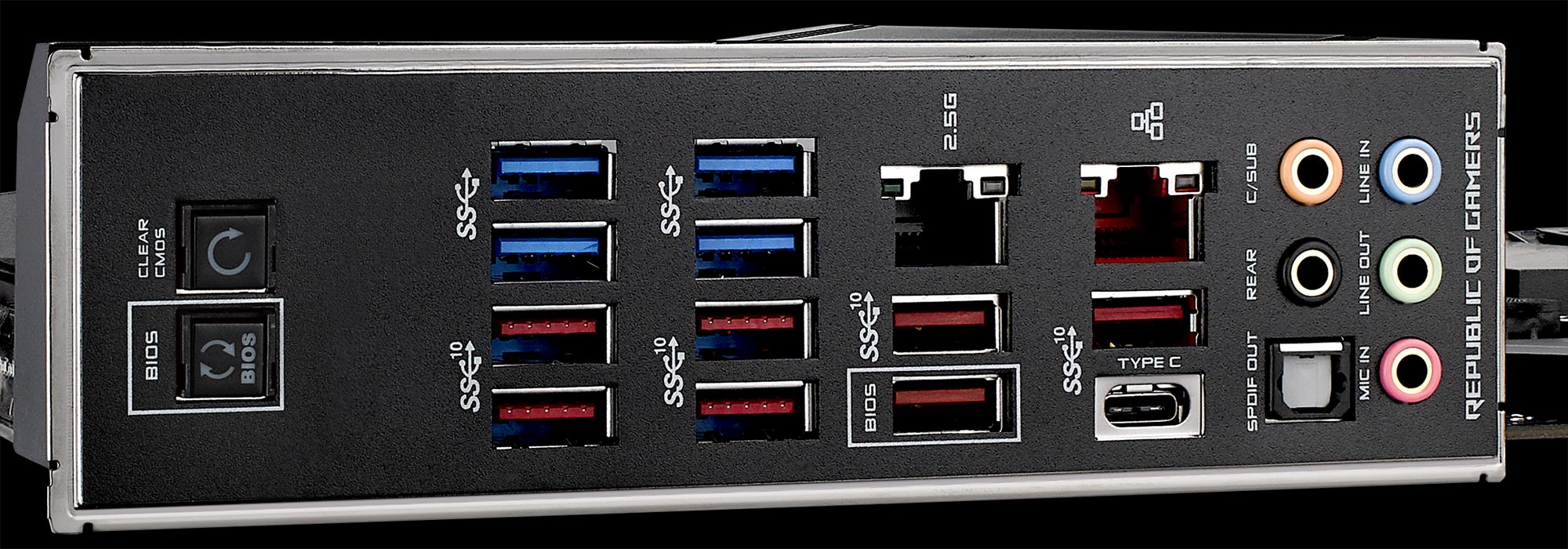
Updating the UEFI is trivial with the integrated EZ Flash tool, which automatically downloads and installs the latest firmware for your board. If you’re building a system and need to update the UEFI to support a recently-released CPU, the USB BIOS Flashback available on select models lets you do that using nothing but a power supply and a USB stick containing the firmware file.
Choosing your champion
The Republic of Gamers was founded way back in 2006, which is a long time ago in computing years. It redefined the meaning of “enthusiast motherboards” with the original Crosshair and has been evolving the formula ever since. Using top-notch components and cutting-edge designs capable of hitting the highest speeds, ROG engineers create motherboards that exude quality and craftsmanship while pushing the boundaries of desktop computing.
The ROG Crosshair VIII series has the biggest arsenal and should be the first choice for hardcore gamers, overclockers, and enthusiasts. Following closely, ROG Strix models are fit for gamers with a keen eye for good looks, high speeds, and quality components that don't need to be embellished by luxuries. Everything you need to know about each model is summarized in the table below and detailed in the sections that follow.
| Crosshair VIII Formula | Crosshair VIII Hero (Wi-Fi) | Crosshair VIII Impact | Strix X570-E Gaming | Strix X570-F Gaming | Strix X570-I Gaming | |
|---|---|---|---|---|---|---|
| Size | ATX | ATX | Mini-DTX | ATX | ATX | Mini-ITX |
| Memory | 4 x DDR4 | 4 x DDR4 | 2 x DDR4 | 4 x DDR4 | 4 x DDR4 | 2 x DDR4 |
| PCIe | 3 x16 1 x1 |
3 x16 1 x1 |
1 x16 | 3 x16 2 x1 |
3 x16 2 x1 |
1 x16 |
| M.2 | 2 x4 | 2 x4 | 2 x4 | 2 x4 | 2 x4 | 2 x4 |
| SATA | 8 | 8 | 4 | 8 | 8 | 4 |
| Ethernet | Aquantia 5G Intel 1G |
Realtek 2.5G Intel 1G |
Realtek 2.5G Intel 1G |
Realtek 2.5G Intel 1G |
Intel 1G | Intel 1G |
| WiFi | 802.11ax | 802.11ax (optional) | 802.11ax | 802.11ax | NA | 802.11ac |
| Audio | SupremeFX S1220 | SupremeFX S1220 | SupremeFX S1220 | SupremeFX S1220A | SupremeFX S1220A | SupremeFX S1220A |
| USB 3.2 Gen2 | 1 front 1 Type-C 7 Type-A |
1 front 1 Type-C 7 Type-A |
1 front 1 Type-C 5 Type-A |
1 front 1 Type-C 7 Type-A |
1 front 1 Type-C 3 Type-A |
1 Type-C 3 Type-A |
| RGB headers | 2 strip 2 Gen2 address |
2 strip 2 Gen2 address |
1 strip 2 Gen2 address |
2 strip 2 Gen2 address |
2 strip 2 Gen2 address |
1 strip 1 Gen2 address |
| Availability (US) | Amazon Newegg |
Amazon Newegg |
TBA | Amazon Newegg |
Amazon Newegg |
TBA |
| Availability (Canada) | Canada Computers | Canada Computers Memory Express |
TBA | Canada Computers Memory Express |
TBA | TBA |
The Crosshair VIII Formula puts the biggest VRMs in town under liquid cooling
Our new Crosshair VIII models set the bar for X570 motherboards. The pack is led by the armor-clad and liquid-ready Crosshair VIII Formula, followed closely by the Crosshair VIII Hero for less extravagant builds. Overclocking fanatics and small system lovers can look to the Mini-DTX Crosshair VIII Impact, a compact board built to shatter records.
The Formula is the flagship of the X570 fleet, primed to be fitted into premium systems with custom liquid-cooling loops and push Ryzen to its limits. Whether you’re looking for utmost functionality or pure aesthetic expression, this board sits at the apex. It would look fantastic just displayed on a wall, let alone in a high-end build.
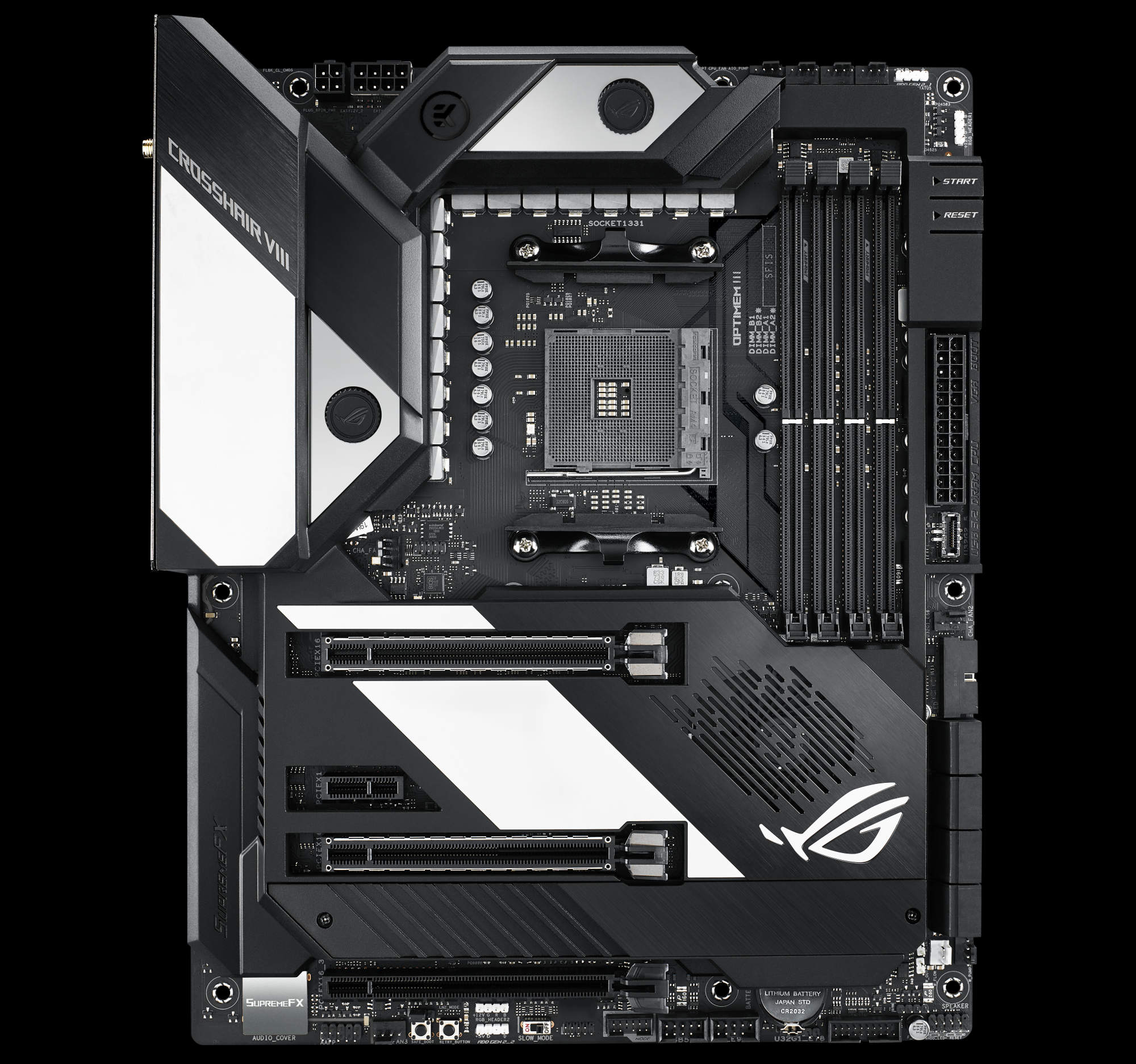
The liquid-fueled centerpiece is the mighty CrossChill EK III water block, a product of our ongoing collaboration with the cooling masters at EK Water Blocks. The block is tapped for standard fittings to ease its installation into an existing loop, and it sits atop one of our biggest VRMs to date. The 16 PowIRstages are accompanied by MicroFine Alloy chokes, with each stage capable of delivering a whopping 60 amps. There’s more than enough power to take a CPU to its limits. The ProCool ATX and eight-pin power headers with solid-core pins and metal covers ensure the board and VRMs get stable, uninterrupted power.
On the integrated I/O shield rests a LiveDash 1.3” OLED display, a handy tool for quickly getting information at a glance, like checking the CPU speed, keeping an eye on BIOS Flashback status, verifying POST codes in case of trouble, or monitoring the motherboard’s copious collection of sensors. Naturally, you can also roll your own custom graphics or display text. Monitoring is a prime aspect of managing a liquid-cooled system, and the Crosshair boards’ dedicated coolant flow rate and temperature headers let you track key metrics. A trio of dual-mode chassis fan headers stand ready, should extra cooling become necessary. Additionally, the Node connector lets attached components communicate their own readings and take control of board features.
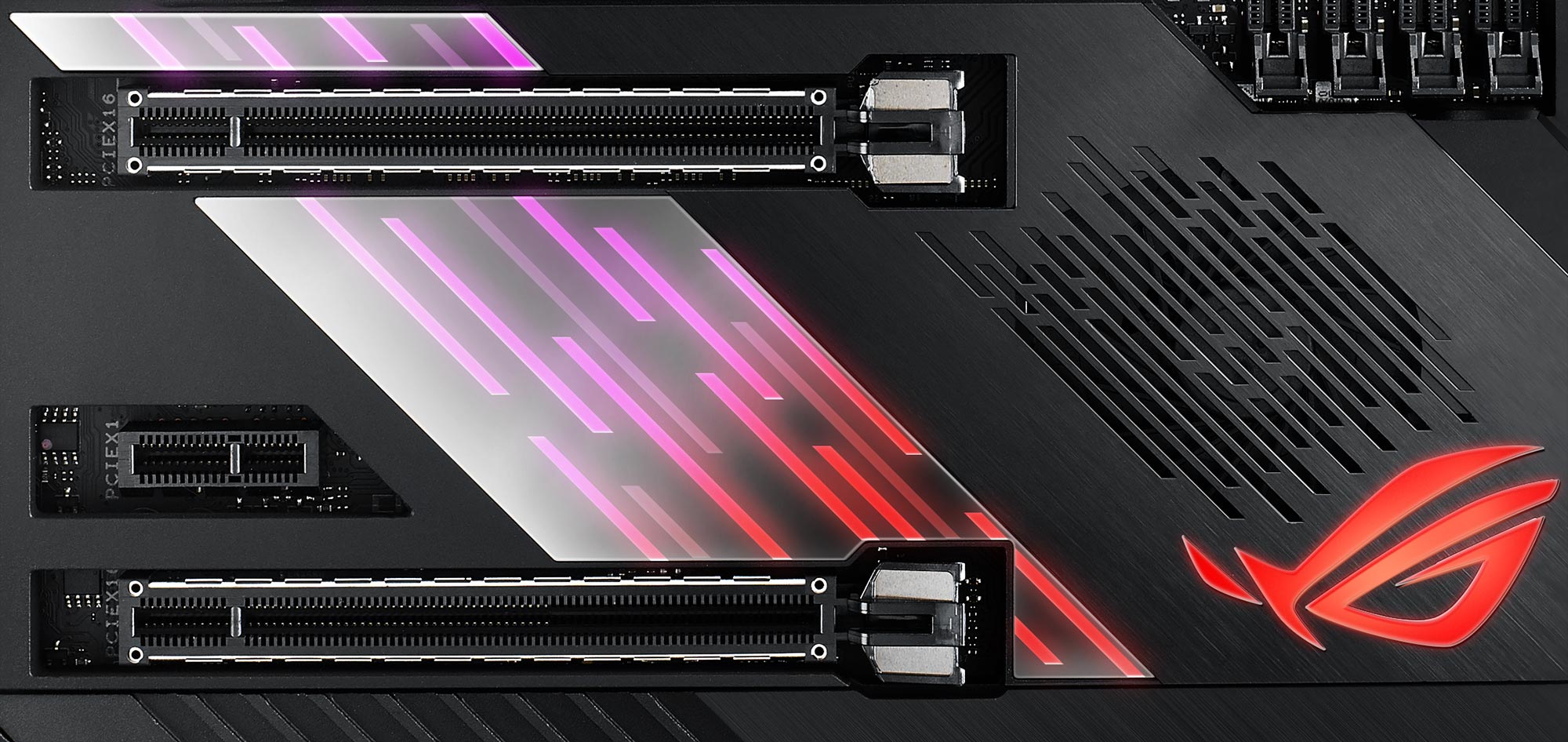
Networking aficionados will find the Formula fulfills their needs and then some. There’s an Intel Wi-Fi 6 adapter ready to send radio waves at multi-gigabit speeds, and next to the Intel Gigabit Ethernet chip sits an Aquantia 5G controller with much higher throughput for moving huge videos and other files. The SupremeFX S1220 codec and its associated circuitry offer audiophile-grade audio reproduction. An ESS Sabre DAC and amp powers the front panel audio output, ready to drive high-impedance hi-fi headphones without breaking a sweat.
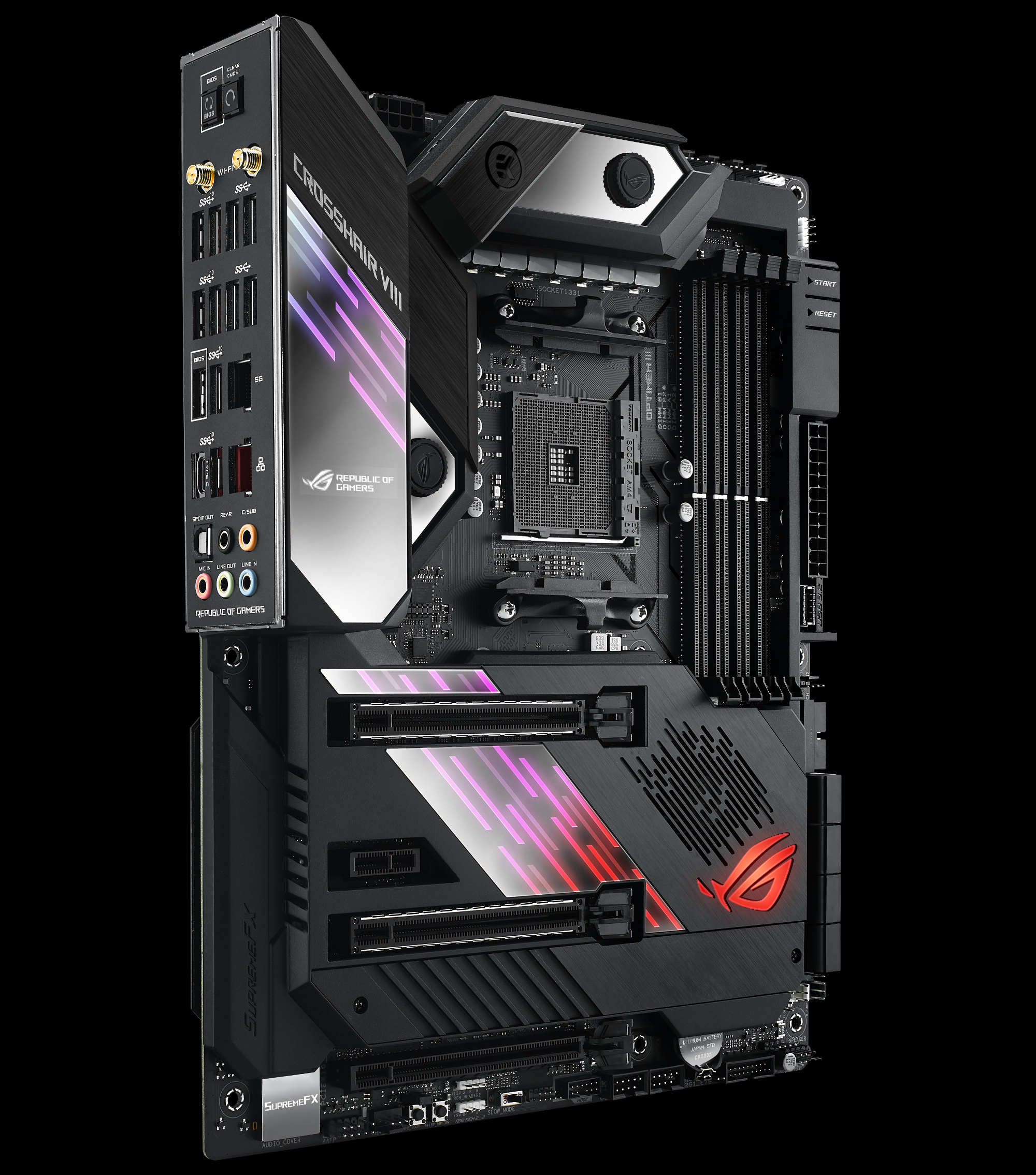
As befits the top model in the lineup, the Formula is reinforced by a metal backplate and SafeSlot treatment for its main PCIe x16 slots. The chipset is covered by an expansive heatsink, while the dual M.2 slots each have their own dedicated heatsinks, sitting underneath the board’s ROG Armor. Alongside headers for standard RGB LED strips, there are ASUS-developed Gen 2 headers for addressable strips. These headers can autodetect the characteristics of connected devices, allowing software to easily tweak effects to match. For added customization, FlexKey lets you remap the reset key to switch Aura Sync or off, boot directly into the UEFI, or Safe Boot with UEFI defaults.
The Formula also comes with a particularly generous allotment of USB ports: 12 at the back panel, and another 9 available through internal headers, including Type-C connectors. You can ditch your USB hub now.
| ROG Crosshair VIII Formula | |
|---|---|
| Size | ATX |
| Memory | 4 x DDR4 |
| Multi-GPU | 2 x SLI, 3 x CrossFireX |
| PCIe | 2 x16: x16, x8/x8 1 x16: x4 3 x1 |
| Storage | 2 x M.2 (NVMe x4 or SATA 6Gbps) 8 x SATA 6Gbps |
| Networking | Aquantia 5G Ethernet Intel I211AT Gigabit Ethernet 2x2 802.11ax (Wi-Fi 6) MU-MIMO Bluetooth 5 |
| Audio | SupremeFX S1220 codec |
| USB | 3.2 Gen 2: 1 x front, 1 x Type-C, 7 x Type-A 3.2 Gen 1: 4 x front, 4 x Type-A 2.0: 4 x front |
| Aura | 2 x strip headers 2 x Gen2 addressable headers |
| Cooling | 2 x pump headers 5 x fan headers 1 x high-amperage fan header 1 x coolant temperature sensor 1 x coolant flow rate sensor |
| Availability (US) | Amazon Newegg |
| Availability (Canada) | Canada Computers |
If you’re building a liquid-cooled home for a new Ryzen CPU, the ROG Crosshair VIII Formula provides a premium foundation. From the design of the power circuitry and liquid-ready VRM cooler to aesthetic touches like the Gen 2 RGB headers and stylish armor, the Formula is the pinnacle of ROG X570 motherboards. Pricing and release date will be announced soon, so stay tuned.
The ROG Crosshair VIII Hero (Wi-Fi) offers glorious air-cooled excess without going overboard
Let’s say the liquid-cooled Formula catches your eye, but you prefer air-cooled rigs or factory-sealed AIO liquid coolers instead of custom loops. Your new best friend is the Crosshair VIII Hero.
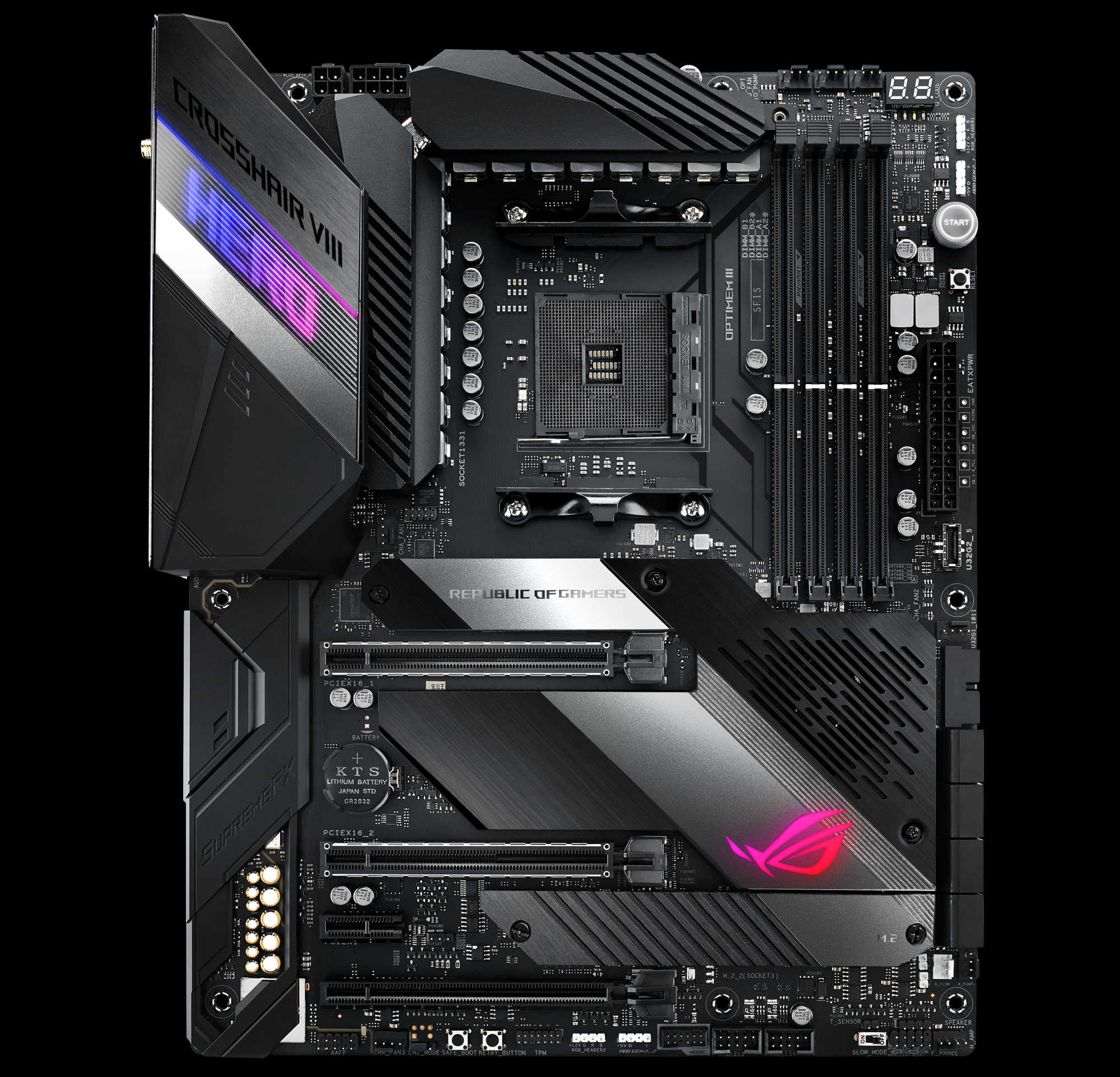
Compared to the Formula, the Hero doesn’t leave much on the table. The voltage regulation module maintains the power stage count at 14+2 based on IR3555 ICs. The VRM heatsink has a massive surface area for better heat distribution. The chipset is covered by a large heatsink, and the two onboard M.2 slots each have their dedicated sinks, ensuring NVMe SSDs won't see any thermal-induced throttling. You can assemble a similarly overpowered rig with the Hero as you can with the Formula, including two-way SLI and three-way CrossFireX setups set to take advantage of the extra bandwidth afforded by graphics cards with PCIe 4.0.
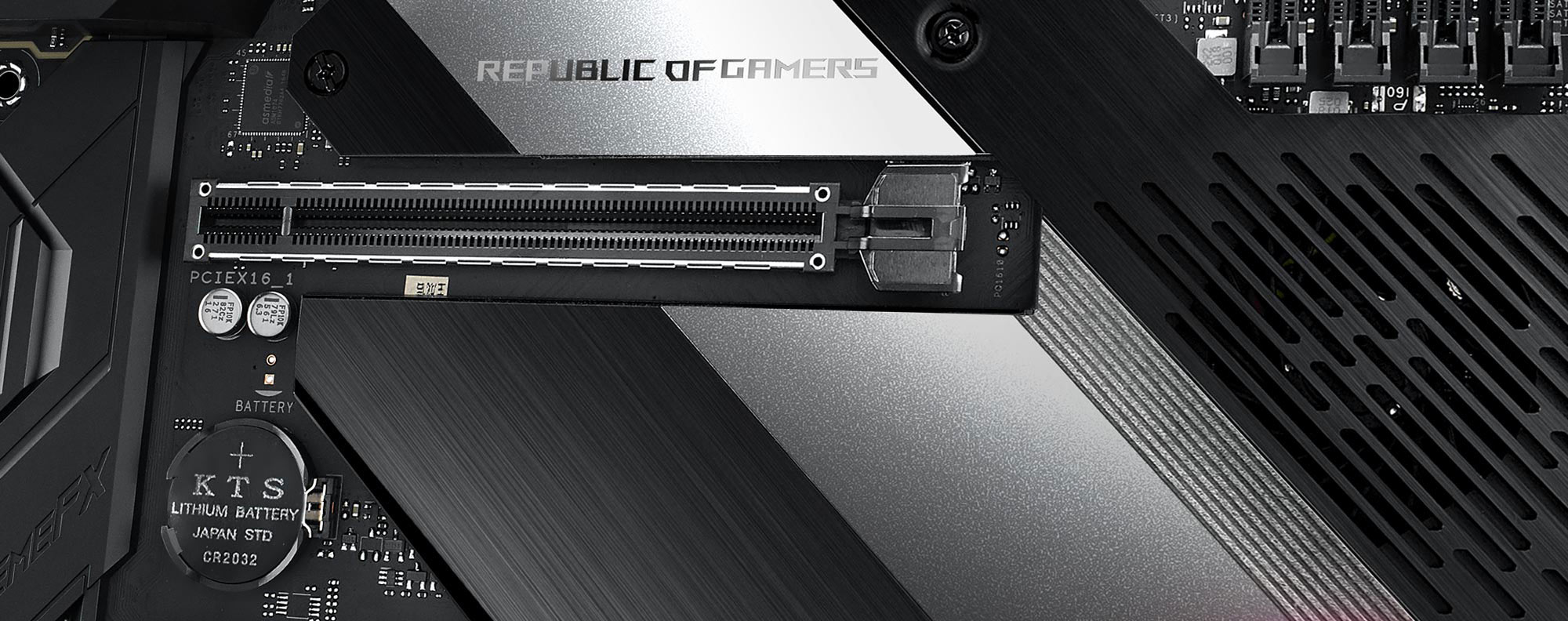
The stealthy PCB and gray accents meld perfectly with Aura Sync lighting, which is integrated into the PCH heatsink and I/O cover, and also supported through a total of two RGB headers plus two Gen2 addressable headers. An onboard Q-Code POST code display also lights up to help troubleshoot failed overclocks. Cooling arrangements can take advantage of plenty of hybrid fan headers, plus connectors for AIO pumps or custom loop pumps.
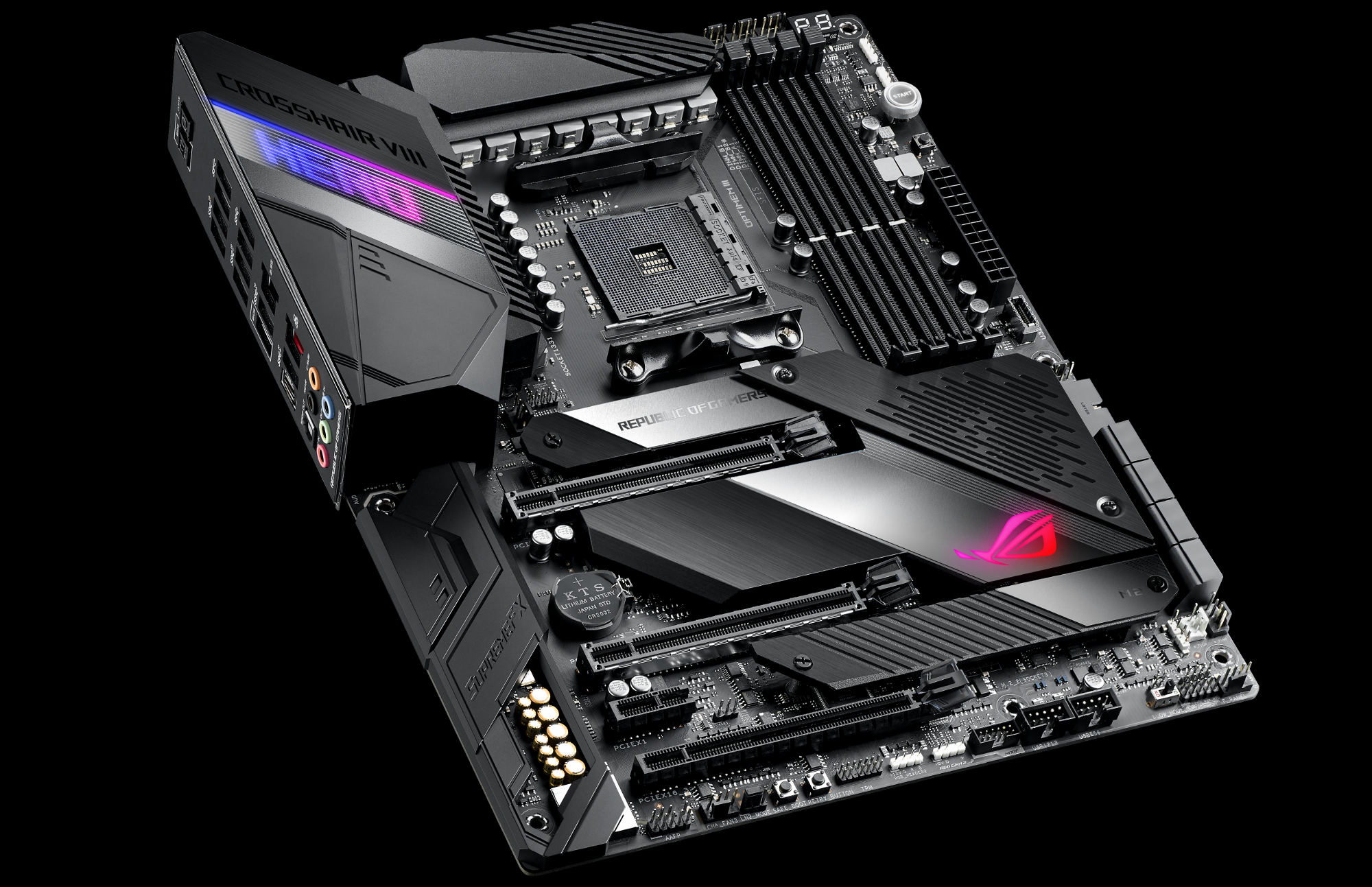
Unlike with the Formula, there’s no metal plate on the back or water block integrated into the VRM heatsink. The LiveDash OLED display is also gone. A 2.5G LAN chip takes the place of the Aquantia 5G controller, and you can opt for a version of the Hero that lacks the Intel Wi-Fi 6 adapter for a purely hardwired setup.
| ROG Crosshair VIII Hero (Wi-Fi) | |
|---|---|
| Size | ATX |
| Memory | 4 x DDR4 |
| Multi-GPU | 2 x SLI, 3 x CrossFireX |
| PCIe | 2 x16: x16, x8/x8 1 x16: x4 3 x1 |
| Storage | 2 x M.2 (NVMe x4 or SATA 6Gbps) 8 x SATA 6Gbps |
| Networking | Realtek 2.5G Ethernet Intel I211AT Gigabit Ethernet 2x2 802.11ax (Wi-Fi 6) MU-MIMO; Bluetooth 5 (optional) |
| Audio | SupremeFX S1220 codec |
| USB | 3.2 Gen 2: 1 x front, 1 x Type-C, 7 x Type-A 3.2 Gen 1: 2 x front, 4 x Type-A 2.0: 4 x front |
| Aura | 2 x strip headers 2 x Gen2 addressable headers |
| Cooling | 2 x pump headers 5 x fan headers 1 x high-amperage fan header 1 x coolant temperature sensor 1 x coolant flow rate sensor |
| Availability (US) | Amazon Newegg |
| Availability (Canada) | Canada Computers Memory Express |
The ROG Crosshair VIII Hero is designed for air-cooled rigs and more conventional liquid cooling. If you’re not building with a custom liquid-cooling loop, the Hero is your ATX entry point into the Crosshair series. Expect more information on pricing and release date in short order.
The ROG Crosshair VIII Impact is a two-DIMM overclocker’s dream
You’d be forgiven for presuming that the biggest motherboards are the natural choice to take a CPU’s clock speed as far as it can possibly go, and perhaps shatter some world records in the process. That’s not always the case, though. The memory controllers inside modern CPUs are complicated, and trying to use four DIMMs in a board at maximum speeds can be challenging. A two-DIMM configuration is often the best path to memory tuning victory as it eases the load on the RAM controller and shortens the length of PCB traces to the slots. The stage is set for the ROG Crosshair VIII Impact.
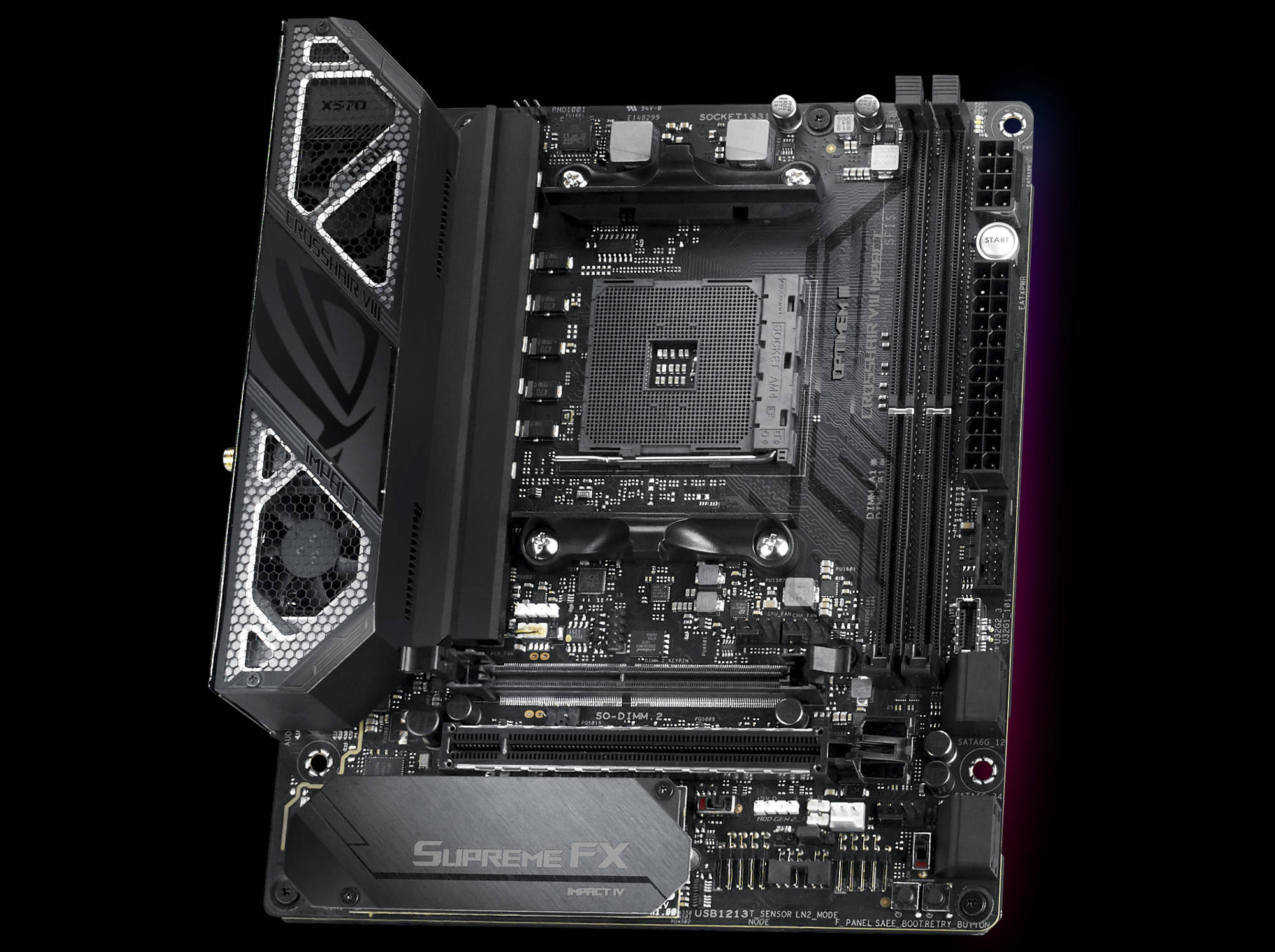
The Impact is a compact, high-performance motherboard based on the mini DTX form factor, which is slightly taller than Mini-ITX. The unusual dimensions were deliberately chosen to take advantage of unused space in Mini-ITX cases designed to support two-slot graphics cards mounted directly to the motherboard. The extra real estate helps us squeeze in additional features along with a VRM that uses TDA21472 power stages in an 8+2 configuration. Each stage is capable of pushing 70A to better feed power to high-end CPUs. To cool the VRM effectively as you turn the MHz up higher, the Impact uses a heatsink with an integrated fan ready to blow a breeze through the fins. A heatpipe connects the VRM sink to a full-size aluminum backplate, spreading out heat quickly and evenly, compensating for limited airflow in smaller chassis. Along with the standard CPU fan connector, the Impact comes with dedicated headers for a pump and two radiator fans, along with headers for monitoring coolant flow and temperature.
We didn’t skimp on features to fit into a smaller footprint; the Crosshair VIII Impact mostly matches its ROG siblings and only drops items that physically won’t fit, like multiple PCIe expansion slots and extra SATA ports that most people don’t need. There are still plenty of PCIe 4.0 lanes for next-gen SSDs, plus Intel-powered Gigabit Ethernet and Wi-Fi 6 networking. The board even has room integrated Aura Sync lighting along with a standard RGB strip header and two Gen 2 addressable strip headers.
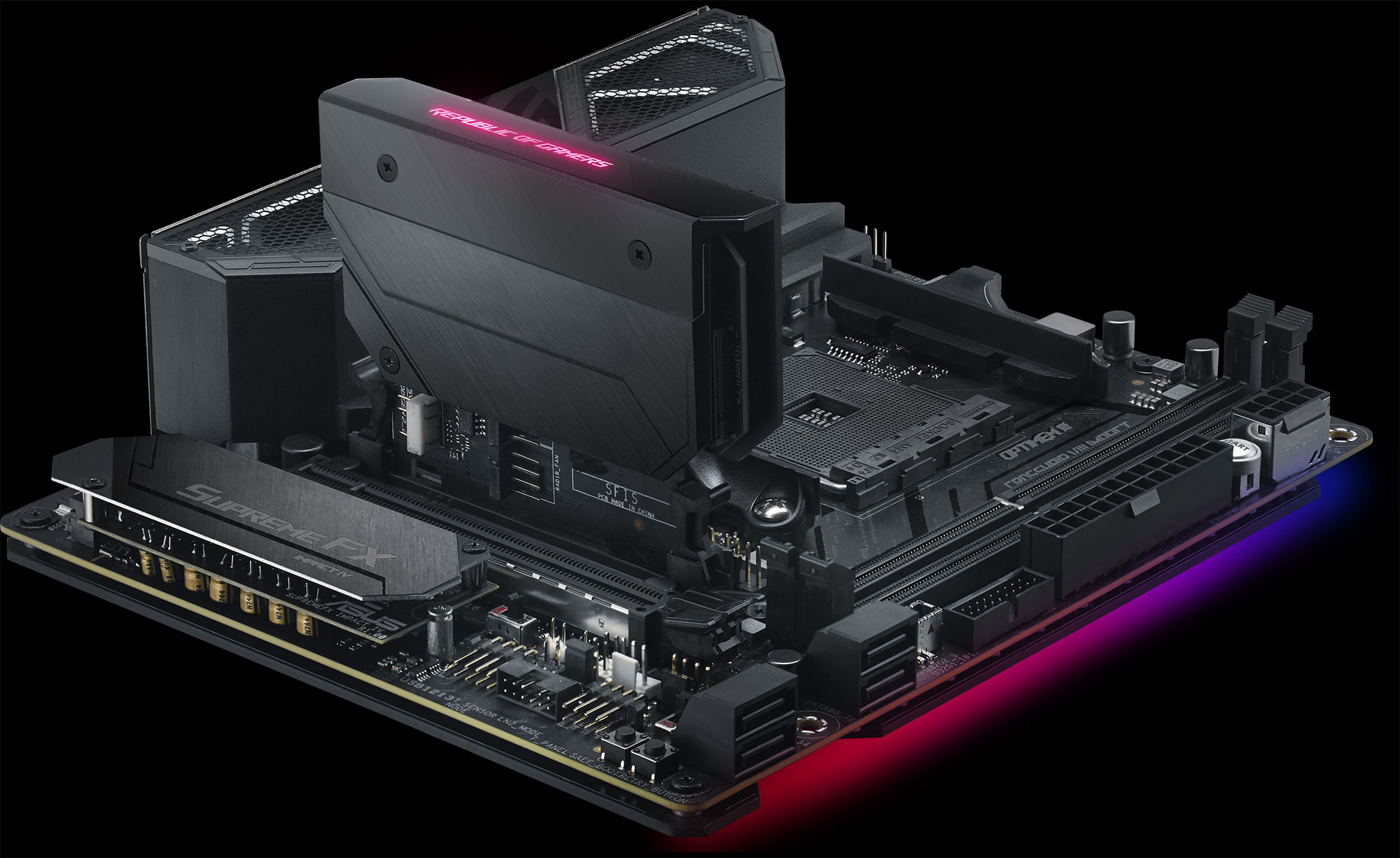
Since surface area is at a premium in this form factor, we create more of our own. The dual M.2 slots are mounted to a new ROG SO-DIMM.2 module that plugs into the board, the SupremeFX S1220 audio codec and its associated high-end circuitry sit on their own PCB, and the diagnostic LEDs, reset and CMOS buttons, and BIOS Flashback port relocate to the aptly-named Impact Control Card. You can use FlexKey to retask the reset button to toggle Aura Sync, boot directly into the UEFI, or trigger a safe boot with board defaults.
| ROG Crosshair VIII Impact | |
|---|---|
| Size | Mini-DTX |
| Memory | 2 x DDR4 |
| Multi-GPU | NA |
| PCIe | 1 x16 |
| Storage | 2 x M.2 (NVMe x4 or SATA 6Gbps) 4 x SATA 6Gbps |
| Networking | Intel I211AT Gigabit Ethernet 2x2 802.11ax (Wi-Fi 6) MU-MIMO; Bluetooth 5 (optional) |
| Audio | SupremeFX S1220 codec |
| USB | 3.2 Gen 2: 1 x front, 1 x Type-C, 5 x Type-A 3.2 Gen 1: 2 x front, 2 x Type-A 2.0: 2 x front |
| Aura | 1 x strip header 2 x Gen2 addressable headers |
| Cooling | 1 x pump header 4 x fan headers 1 x coolant temperature sensor 1 x coolant flow rate sensor |
| Availability (US) | TBA |
| Availability (Canada) | TBA |
Whether you’re gunning for Ryzen overclocking records or simply want to build a small-form-factor PC whose size belies the power inside, the ROG Crosshair VIII Impact is the obvious option. Pricing and release date will be announced closer to general availability.
Everyone can be a winner with ROG Strix
ROG Crosshair motherboards include the most exotic features for demanding builders creating complicated rigs that push the limits. Gamers don’t always need that level of luxury, so the Strix series retains ROG’s style, performance, and overclocking cred while avoiding niche features that might go unused. For the latest Ryzen platform, we have two full-size ATX boards—the ROG Strix X570-E and X570-F Gaming—along with a Mini-ITX tiny terror in the Strix X570-I Gaming.
The Strix X570-E and X570-F Gaming are two ministers in the Republic of Gamers
The first thing you’ll probably notice about the ROG Strix X570-E and X570-F is their dazzling looks. The I/O cover and PCH heatsink are styled with an ROG cyber-text motif that works in tandem with Aura Sync accents to create a high-tech look.
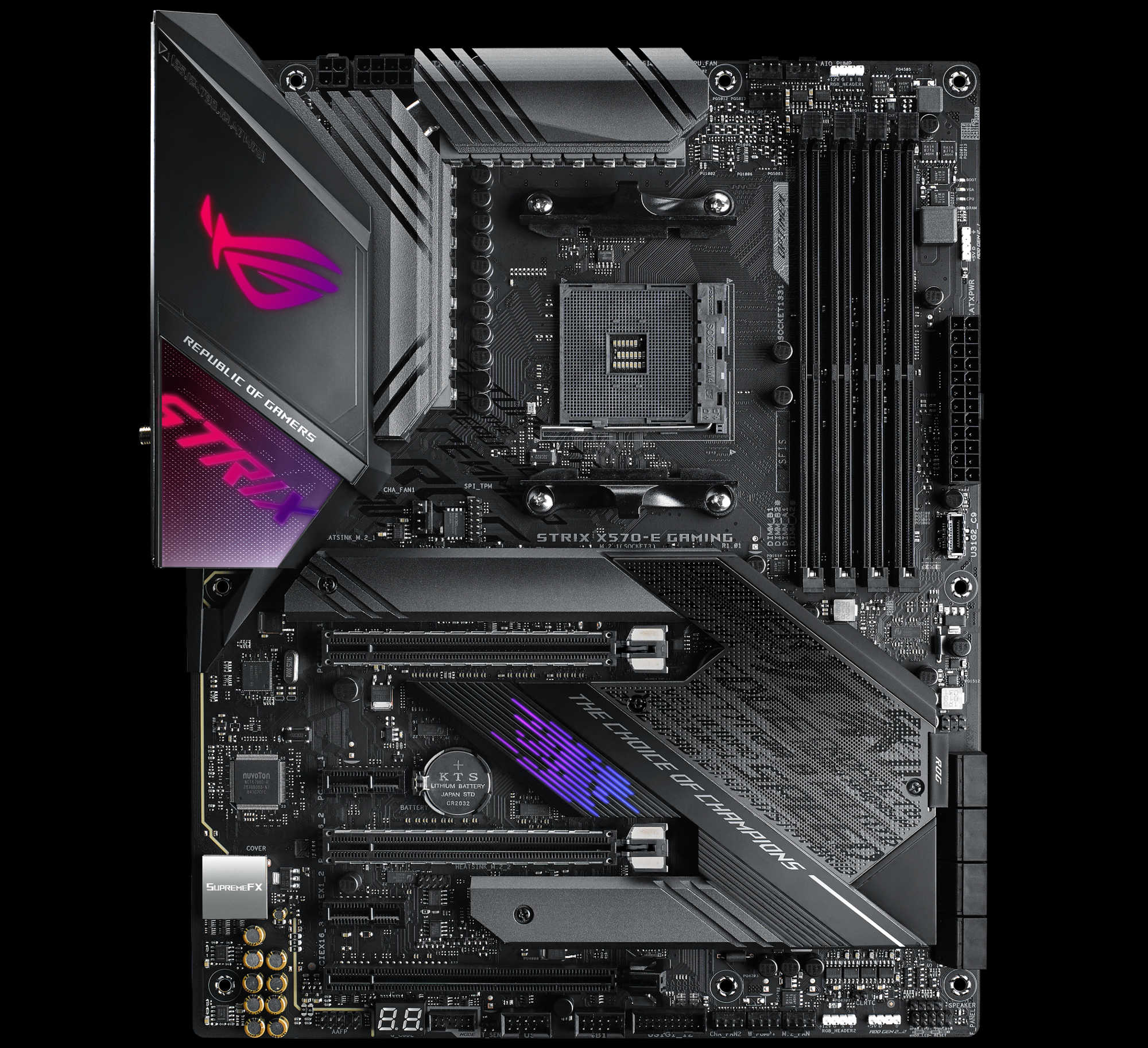
To get a Ryzen CPU overclocked to top speed, the X570-E relies on a Digi+ VRM with 12+4 power stages similar to the higher-end Crosshair models, while the X570-F follows closely behind with 12+2 power stages. In both cases, 8-mm copper heatpipes distribute thermal energy across the VRM heatsinks to improve dissipation.
Memory kits with speeds well in excess of 3000 MT/s are commonplace these days, and Ryzen processors benefit from being paired with faster RAM. OptiMem tech on both boards offers improved signaling for added stability and higher performance when tweaking RAM, letting you take advantage of every drop of performance on tap. Cooling fast systems requires a steady flow of liquid or air, and the Strix boards offer two chassis hybrid fan headers along with AIO and custom pump headers for that endeavor.
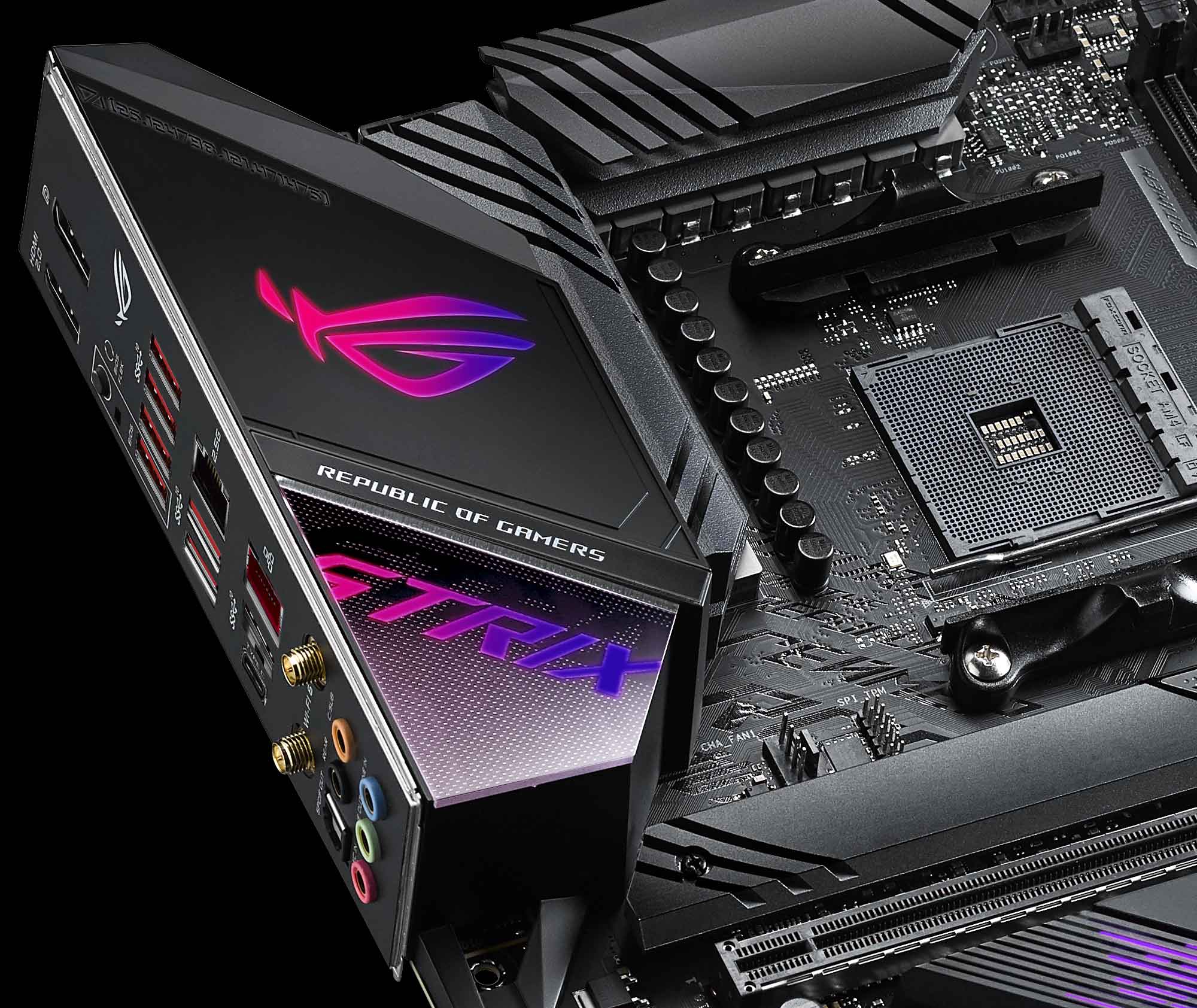
ProCool-reinforced eight-pin connectors ease current into the power stages feeding the CPU. The two PCIe 4.0 x16 connectors employ our SafeSlot reinforcements for better holding heavier graphics cards that tend to push down hard on the slot. The x1 slots also enjoy PCIe 4.0 connectivity, as do the two M.2 slots sitting under heatsinks that cool faster NVMe SSDs. From SLI or CrossFireX multi-GPU setups to blazing-fast SSD RAID arrays, the X570-E and X570-F can do it all.
Although these boards don’t sit in the upper echelons of the ROG family, they nevertheless share most of the high-end features, both practical and aesthetic. Both offer FlexKey reset key reassignment and a USB port with BIOS Flashback support if something goes wrong during a firmware update. The I/O shields are pre-mounted for ease of installation and dashing good looks, and the Strix X570-E Gaming has a Q-Code diagnostic LED display to help with troubleshooting. The Aura Sync-enabled array of Gen2 addressable and standard RGB strip headers makes it easy to create any kind of lighting design, from moody ambience to blazing animated effects. A bidirectional Node connector lets other components talk to the board and exchange system info and control signals.
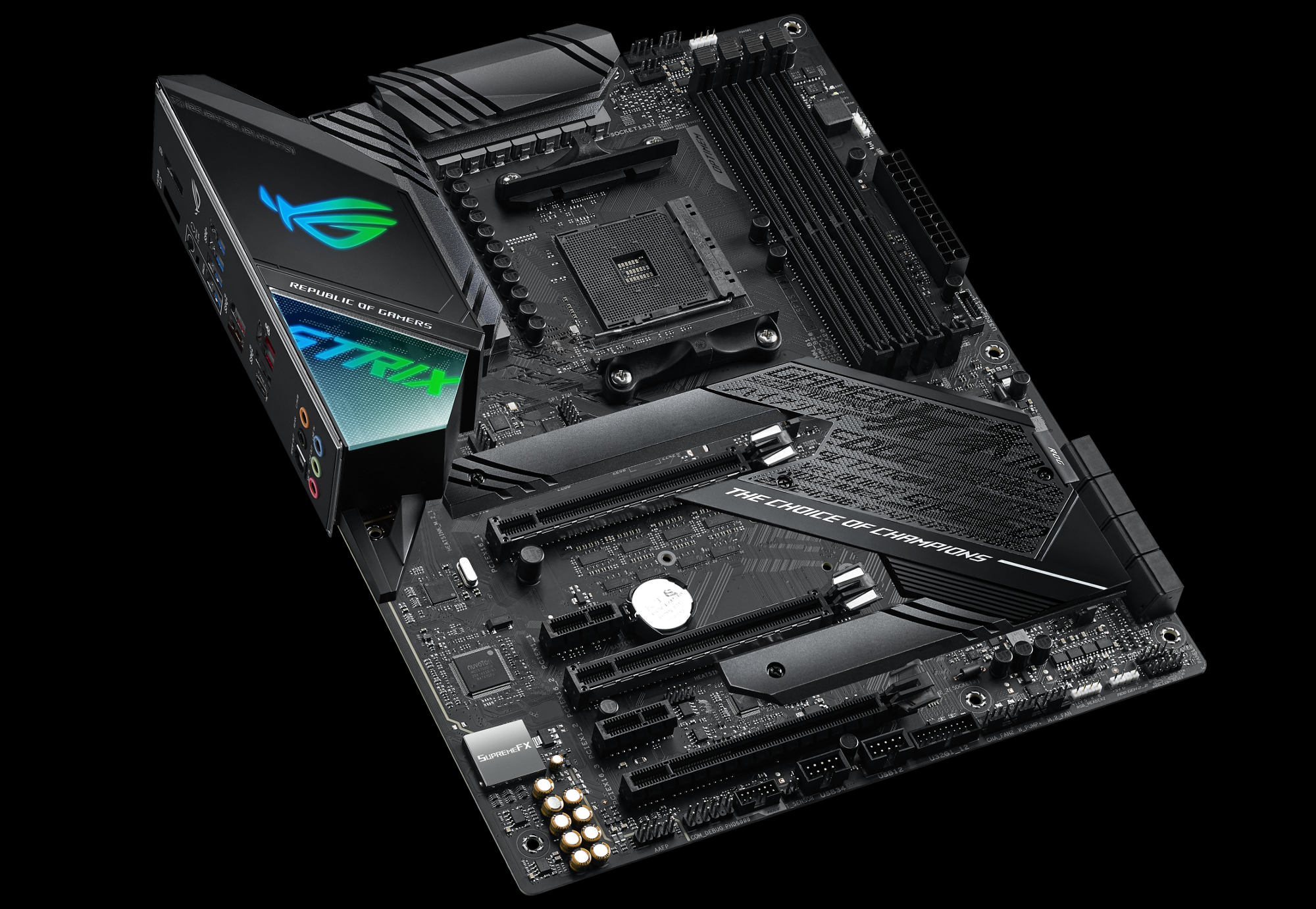
Pinpoint-accurate sound is key to competitive gaming, and the SupremeFX S1220A codec on this Strix pair cleanly identifies enemies in 3D space. Its 120 dB output signal-to-noise ratio is on par with audiophile equipment for perfect sonic accuracy, while the 113 dB-SNR microphone input lets your teammates hear you clearly. The quality of Gigabit Ethernet implementations can vary, but these boards use reliable Intel controllers protected by LANGuard reinforcement and electrical shielding. The X570-E has same upgraded networking loadout as the Crosshair Hero, with a 2.5G Ethernet controller and Intel Wi-Fi 6 AX200 adapter, while the X570-F sticks to 1G Ethernet. It also reduces the number of USB ports to keep costs down for more modest rigs that lack loads of peripherals.
| ROG Strix X570-E Gaming | ROG Strix X570-F Gaming | |
|---|---|---|
| Size | ATX | |
| Memory | 4 x DDR4 | |
| Multi-GPU | 2 x SLI, 3 x CrossFireX | |
| PCIe | 2 x16: x16, x8/x8 1 x16: x4 2 x1 |
|
| Storage | 2 x M.2 (NVMe x4 or SATA 6Gbps) 8 x SATA 6Gbps |
|
| Networking | Realtek 2.5G Ethernet Intel I211AT Gigabit Ethernet 2x2 802.11ax (Wi-Fi 6) MU-MIMO; Bluetooth 5 (optional) |
Intel I211AT Gigabit Ethernet |
| Audio | SupremeFX S1220A codec | |
| USB | 3.2 Gen 2: 1 x front, 1 x Type-C, 7 x Type-A 3.2 Gen 1: 2 x front 2.0: 4 x front |
3.2 Gen 2: 1 x front, 1 x Type-C, 3 x Type-A 3.2 Gen 1: 2 x front, 4 x Type-A 2.0: 4 x front |
| Aura | 2 x strip headers, 2 x Gen 2 addressable headers |
|
| Cooling | 2 x pump headers 4 x fan headers |
|
| Availability (US) | Amazon Newegg |
Amazon Newegg |
| Availability (Canada) | Canada Computers Memory Express |
TBA |
The Strix X570-E Gaming is the one to pick for overclocking prowess and faster networking. Stay tuned for information on pricing and release date.
Strix X570-I Gaming is proof that the best things do come in small packages
If you think the ROG Crosshair VIII Impact is an interesting board, what if you could get most of its equipment and overclocking prowess in a more reasonably priced package with an even smaller form factor? Enter the Strix X570-I Gaming.
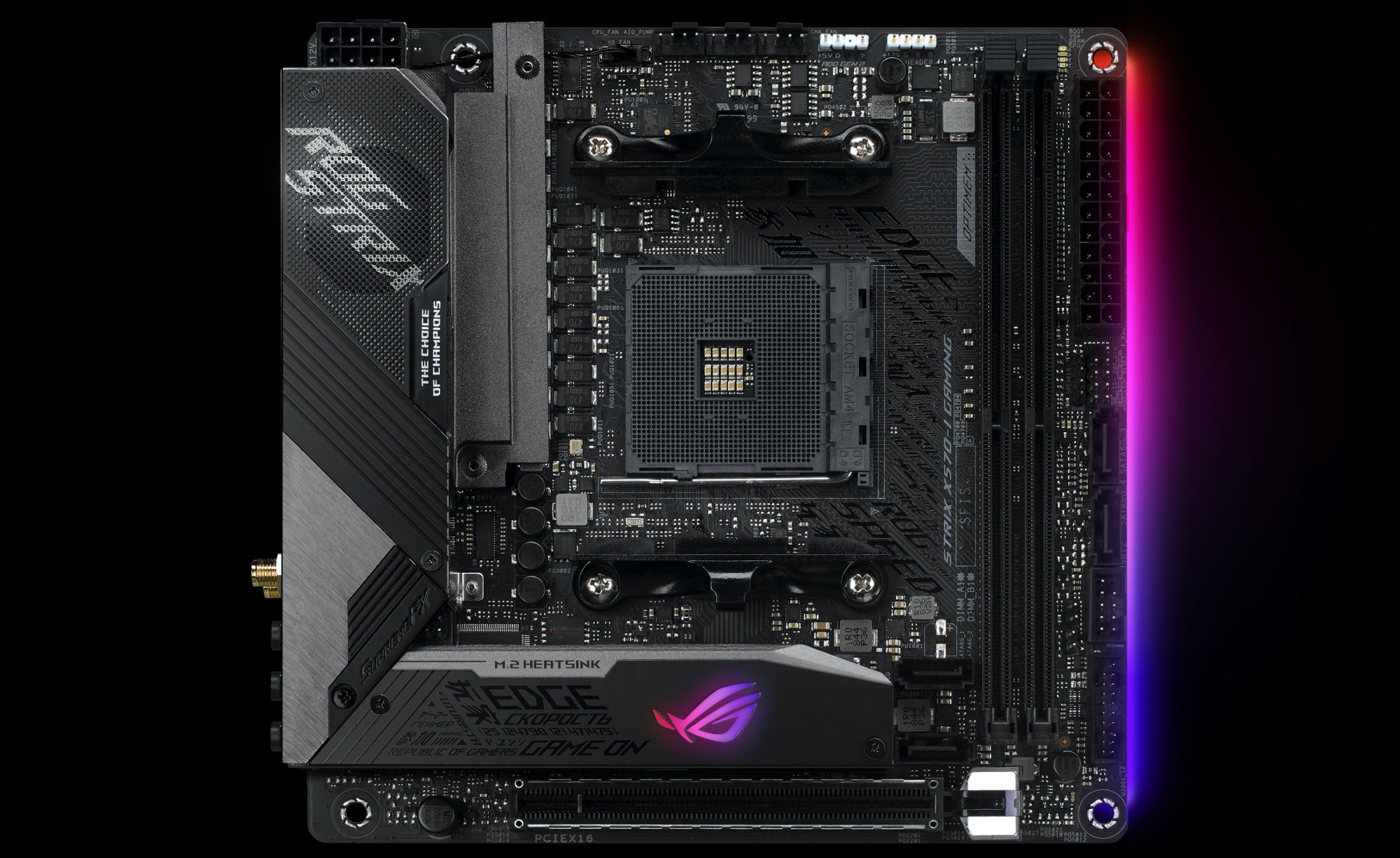
This model is slightly more compact than the Impact and fits the tried-and-true Mini-ITX form factor. The digital VRM comprising 8+2 power stages is exceedingly powerful for such a small motherboard, and resides under a heatsink with its own fan and an attached metal backplate that ensures heat gets pulled away from the ICs more effectively. This cooling arrangement lets you push voltages up while keeping temperatures down. As an added bonus, the VRM fan prevents overheating in compact cases with limited airflow, even if overclocking isn’t in the cards. Meanwhile, the second heatsink that goes across the X570 chipset has copper heatpipes to increase heat dissipation area and is topped by an independent fan. While tiny systems don’t usually offer a ton of cooling, the X570-I still offers an AIO pump header alongside the hybrid fan header. Should an aggressive overclocking attempt go awry, the diagnostic LEDs will tell you what went wrong during the POST process.
We make the most of every available square inch of PCB area and even turn some limitations into benefits. Along with OptiMem enhancements, the presence of only two memory slots that sit closer to the CPU allows much shorter circuit traces than full-sized boards, helping the X570-I more easily overclock. The PCIe x16 SafeSlot and dual M.2 slots are wired for extra bandwidth with support for next-gen PCIe 4.0 graphics cards and NVMe SSDs.
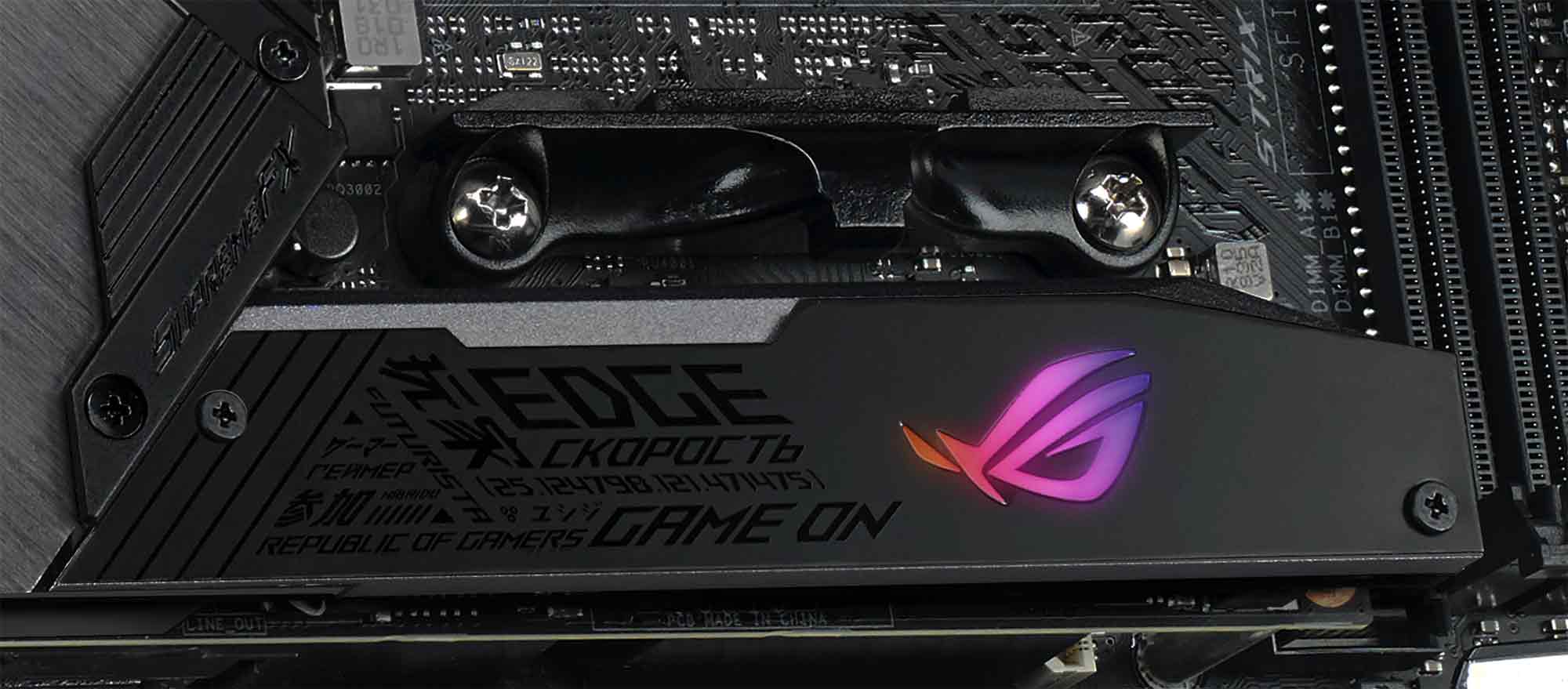
Small-form-factor systems often serve as home-theater PCs or couch gaming machines, so for maximum flexibility we spec the Strix-I with built-in HDMI 2.0 and DisplayPort 1.4 outputs, along with the same Intel Wi-Fi 6 adapter with Bluetooth 5.0 support as the bigger members of the ROG family. Gigabit Ethernet is included, as well, powered by an Intel adapter, protected by LANGuard, and with packets prioritized by GameFirst V. All the cooling-related headers sit flush with the top of the board to simplify cable routing. Gen2 addressable and standard RGB strip headers allow additional Aura Sync lighting to complement the illuminated heatsink and glowing right edge of the board.
| ROG Strix X570-I Gaming | |
|---|---|
| Size | Mini-ITX |
| Memory | 2 x DDR4 |
| Multi-GPU | NA |
| PCIe | 1 x16 |
| Storage | 2 x M.2 (NVMe x4 or SATA 6Gbps) 4 x SATA 6Gbps |
| Networking | Intel I211AT Gigabit Ethernet 2x2 802.11ax (Wi-Fi 6) MU-MIMO Bluetooth 5 (optional) |
| Audio | SupremeFX S1220A codec |
| USB | 3.2 Gen 2: 1 x Type-C, 3 x Type-A 3.2 Gen 1: 2 x front, 4 x Type-A 2.0: 2 x front |
| Aura | 1 x strip header 1 x Gen2 addressable header |
| Cooling | 1 x pump header 2 x fan headers |
| Availability (US) | TBA |
| Availability (Canada) | TBA |
Whether you want to build a speedy HTPC, a compact gaming machine that can run circles around any console, or a compact desktop that can sit easily on a desk or shelf, the Strix X570-I Gaming fits the bill. Look for information on a release date and prices soon.
We announced a lot of hot new tech at Computex 2019. You can find all of the latest gear from ASUS and ROG in this article.

